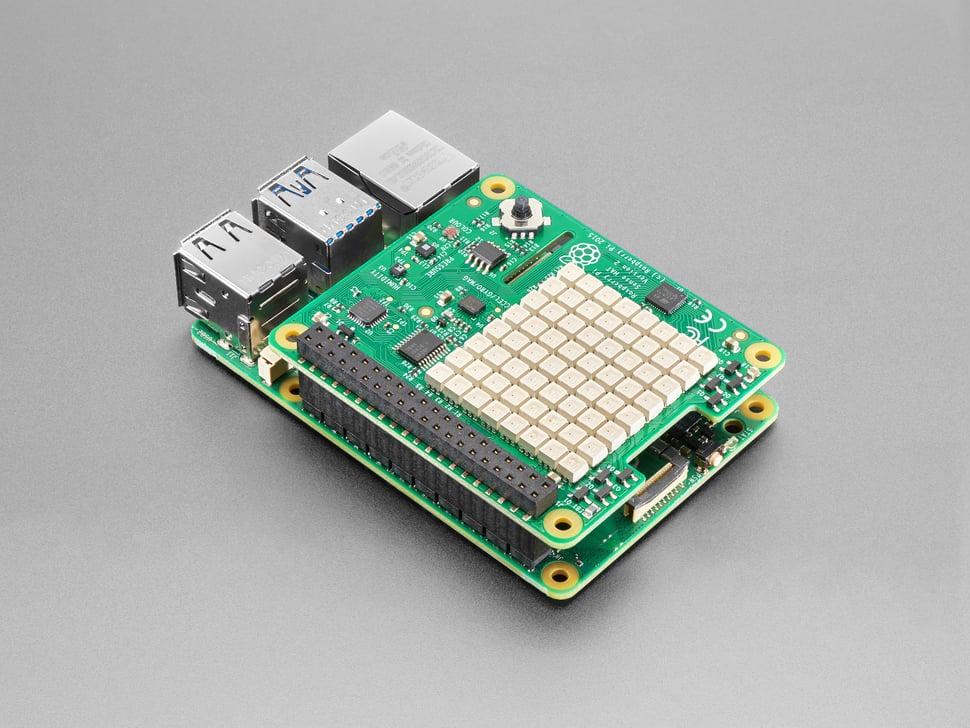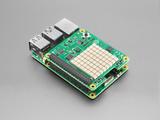Adafruit Raspberry Pi Sense HAT - any Raspberry Pi with 2x20 Connector

Description
Control the same hardware as used in space and build your very own Astro Pi with the new Raspberry Pi Sense HAT! The Sense HAT attaches on top of the Raspberry Pi using 40 GPIO pins to create an 'Astro Pi'. It's equipped with multiple integrated circuit-based sensors, making it versatile for experiments, applications, and even games. It’s also used alongside the Raspberry Pi Foundation to perform science experiments aboard the International Space Station (ISS).
The sensors allow you to measure orientation (yaw, pitch, and roll) using an accelerometer, 3D gyroscope, and magnetometer; in addition to pressure, humidity, and temperature. Engage in various Raspberry Pi projects, such as checking the speed of the Pi, measuring temperature and humidity, and determining the direction the Raspberry Pi is facing.
The 8x8 LED Matrix can display data from different sensors, guide you to geomagnetic North with a compass program using the magnetometer, or simply play games like Tetris, Pong, and Snake with the joystick. The joystick also enables user interaction with programs running on the Raspberry Pi Sense HAT.
Crafting programs for the Sense HAT is straightforward with an available Python library for quick and easy setup. For innovative project ideas, visit the AstroPi website, which provides a variety of ideas and instructions.
To install, connect your Sense HAT to the Raspberry Pi via the 40 GPIO Pins, open a terminal, and execute the command: wget -O - http://www.raspberrypi.org/files/astro-pi/astro-pi-install.sh --no-check-certificate | bash. This takes about 5 minutes for the Raspberry Pi 2 Model B, or approximately 20 minutes for earlier models. Reboot your Raspberry Pi when installation is complete.
Note: The Raspberry Pi Sense HAT is compatible with any Raspberry Pi featuring 40 pin (2x20) connectors, including Pi 5, Raspberry Pi 4, Pi 3, Raspberry Pi 2, Model B+, and Model A+, excluding earlier 26-pin models of Raspberry Pi 1 Model B & A’s. Pi is not included!
Properties
| Brand | Adafruit |
| Model | 2738 |
Delivered in 10 to 30 days
Customer questions
Customer Reviews
- In stock Adafruit NOOds - Flexible LED Filament - 3V 300mm long - Red € 8,75 View product
- In stock Adafruit IR Break Beam Sensors with Premium Wire Header Ends - 3mm LEDs € 3,50 View product
- In stock Adafruit Breadboard-friendly 2.1mm DC barrel jack € 1,25 View product
- In stock Adafruit IR Break Beam Sensor with Premium Wire Header Ends - 5mm LEDs € 7,- View product
- In stock Adafruit Small Enclosed Piezo w/Wires € 1,25 View product
- In stock Adafruit Mini Basic PIR Sensor - BL412 € 2,50 View product
- In stock Adafruit Stainless Thin Conductive Thread - 2 ply - 23 meter/76 ft € 8,25 View product
- In stock Adafruit NOOds - Flexible LED Filament - 3V 300mm long - Blue € 8,75 View product
- In stock Adafruit 2 x CR2032 Coin Cell Battery Holder - 6V output - On/Off switch € 2,50 View product
- In stock Adafruit Pressure-Sensitive Conductive Sheet (Velostat/Linqstat) € 5,75 View product
- In stock Adafruit Stacking Headers for Feather - 12-pin and 16-pin female headers € 1,50 View product
- In stock Adafruit Stereo 3.7W Class D Audio Amplifier - MAX98306 € 10,50 View product
- In stock Adafruit Mono 2.5W Class D Audio Amplifier - PAM8302 € 4,75 View product
- In stock Adafruit White LED Backlight Module - Medium 23mm x 75mm € 3,- View product
- In stock Adafruit NOOds - Flexible LED Filament - 3V 300mm long - Lime Green € 8,25 View product










